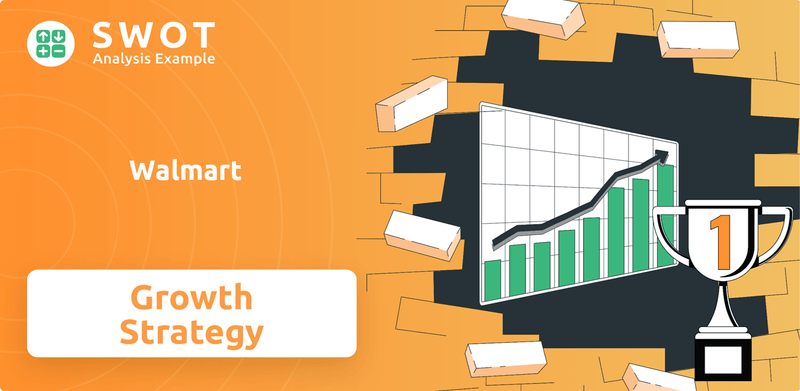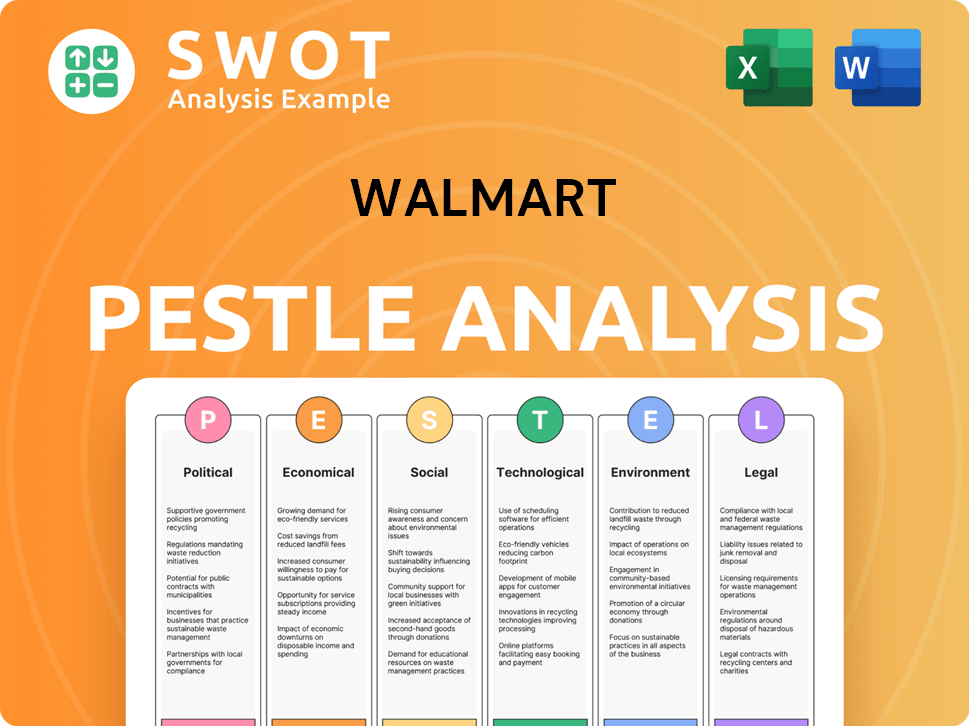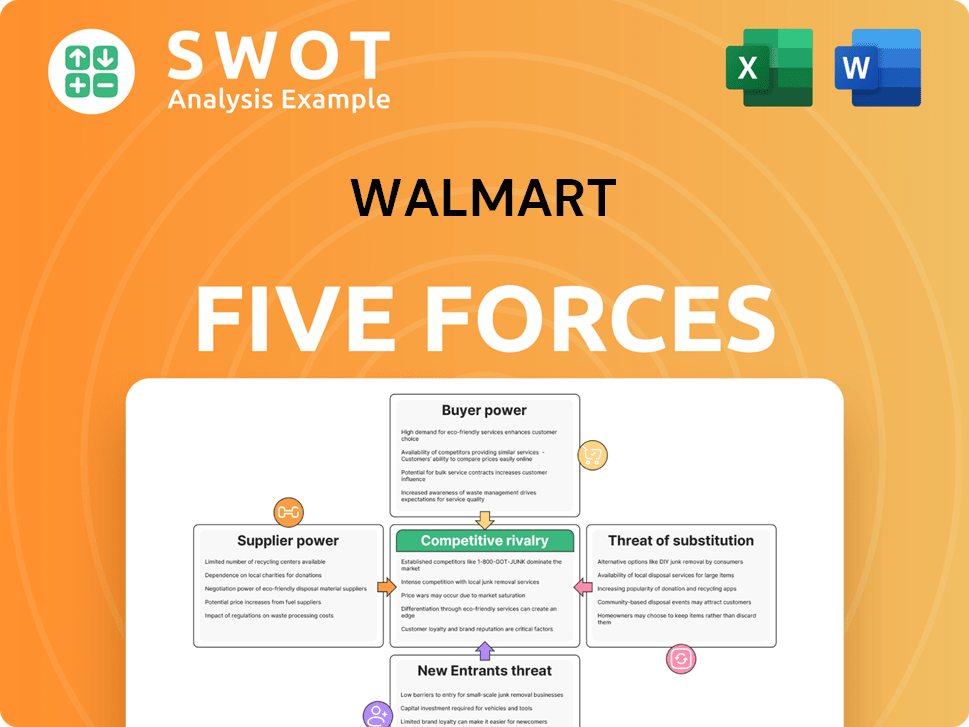Walmart Bundle
Can Walmart Maintain Its Retail Dominance?
Since its inception, Walmart has revolutionized the retail industry, evolving from a single discount store to a global powerhouse. This journey, fueled by a commitment to everyday low prices and strategic innovation, has positioned Walmart as a leader in the competitive market. Understanding Walmart's Walmart SWOT Analysis is key to grasping its intricate growth strategies and future prospects.

This comprehensive analysis explores Walmart's ambitious growth strategy, examining its e-commerce expansion, technological advancements, and international plans. We'll delve into how Walmart navigates evolving retail industry trends, leveraging its market share and omnichannel retail strategy to secure its long-term growth outlook. Furthermore, we'll assess Walmart's financial performance analysis, sustainability efforts, and potential for mergers and acquisitions, providing actionable insights for investors and business strategists alike.
How Is Walmart Expanding Its Reach?
The Walmart growth strategy is centered on aggressive expansion across multiple fronts. This includes physical store modernization, e-commerce enhancements, and strategic acquisitions. The company aims to capture a larger share of the retail market by catering to evolving consumer preferences and leveraging technological advancements.
Walmart's future prospects are closely tied to its ability to adapt to retail industry trends. The company is investing heavily in its omnichannel capabilities, aiming to provide seamless shopping experiences. This strategy is designed to enhance customer convenience and drive sales growth.
Walmart company analysis reveals a focus on both domestic and international expansion. The company is actively pursuing new market entries and strengthening its presence in existing markets. This expansion is supported by a robust supply chain and a commitment to innovation.
Walmart is modernizing its physical store footprint, with plans to open or convert numerous supercenters. The first 'Store of the Future' opened in Cypress, Texas, in April 2025. These stores integrate various services like pharmacies, clinics, and local businesses. New supercenters are slated for states like Texas, Utah, and California in 2025.
Walmart is significantly investing in its e-commerce capabilities to enhance its omnichannel retail strategy. By late 2025, the company plans to reach 95% of U.S. households within three hours for e-commerce fulfillment. This includes expanding online grocery service and same-day delivery options.
Walmart is expanding higher-profit segments like advertising, marketplace, and fulfillment services. Marketplace revenue soared 37% in 2024, and sellers using Walmart Connect advertising grew by 50%. The company is also focused on growing its Walmart+ membership, which has become a $2 billion revenue stream.
Walmart's international expansion plans aim to achieve $200 billion in global marketplace Gross Merchandise Volume (GMV) by 2028. This strategy is fueled by acquisitions like Flipkart in India and a 35% membership surge of Sam's Club in China. The company is also investing in U.S. suppliers to optimize its supply chain.
Walmart's potential for mergers and acquisitions is a key part of its growth strategy. In February 2024, the acquisition of Vizio for $2.3 billion enhanced its advertising capabilities. Other acquisitions like Jet.com, Alert Innovation, and Cornershop have also strengthened Walmart's market position.
- The Vizio acquisition boosts advertising capabilities through the SmartCast operating system.
- Jet.com expanded e-commerce capabilities.
- Alert Innovation enhances automation and robotics.
- Cornershop supports on-demand grocery delivery.
Walmart SWOT Analysis
- Complete SWOT Breakdown
- Fully Customizable
- Editable in Excel & Word
- Professional Formatting
- Investor-Ready Format

How Does Walmart Invest in Innovation?
To understand the innovation and technology strategy of the company, it's essential to recognize the evolving customer needs and preferences within the retail industry. Consumers now demand seamless shopping experiences, combining the convenience of online platforms with the tangible benefits of physical stores. This shift necessitates a robust omnichannel approach, integrating digital and physical channels to meet diverse customer expectations.
The modern consumer seeks personalized experiences, efficient service, and sustainable practices. They value convenience, with options like online grocery pickup and same-day delivery becoming increasingly important. Moreover, customers are more conscious of a company's environmental impact, pushing retailers to adopt sustainable practices and transparent supply chains.
The company's response to these evolving needs is a comprehensive digital transformation strategy, leveraging technology to enhance its omnichannel capabilities and drive sustained growth. This strategy focuses on integrating advanced technologies like AI, automation, and predictive analytics across its operations to meet and exceed customer expectations.
The company is undergoing a profound digital transformation, shifting from a traditional brick-and-mortar focus to a tech-powered retail model. This involves significant investments in e-commerce, supply chain optimization, and customer experience enhancements. This transformation is crucial for maintaining its market share and adapting to the rapidly changing retail industry trends.
A core element of the company's strategy is the transformation of its supply chain into an omnichannel network. This involves leveraging stores, fulfillment centers, and distribution centers with data, intelligent software, and automation. The company aims to automate 65% of its stores by 2026.
The company is heavily investing in AI and automation to streamline operations. This includes AI-driven logistics, procurement, and inventory management. It is also using AI-powered chatbots for supplier negotiations, which has resulted in cost reductions and extended payment terms with a significant percentage of suppliers.
The company is expanding its e-commerce capabilities and developing new digital platforms to offer a more integrated and personalized shopping experience. This includes online grocery pickup and delivery services. The company's e-commerce expansion is a key driver of its future prospects.
The company is experimenting with metaverse e-commerce experiences on platforms like Roblox (April 2024), Walmart Realm (May 2024), and Zepeto (January 2025) to gather user data and explore new commerce possibilities. This initiative reflects the company's investment in technology and its forward-thinking approach to retail.
While the company has made strides in sustainability, it anticipates falling short of its 2025 packaging sustainability targets. Despite these challenges, the company remains committed to waste reduction and is focused on sourcing key commodities from certified regional suppliers. Understanding the Target Market of Walmart is important to understand the company's sustainability efforts.
The company's strategic initiatives are centered around leveraging cutting-edge technologies to enhance its operations and customer experience. These initiatives are crucial for maintaining its competitive advantages in the retail industry and driving long-term growth.
- AI and Automation: Implementing AI across the supply chain, including logistics, procurement, and inventory management, to improve efficiency and reduce costs.
- Omnichannel Network: Integrating stores, fulfillment centers, and distribution centers to create a seamless shopping experience for customers. Over 50% of its e-commerce fulfillment center volume now flows through next-generation fulfillment centers.
- E-commerce Expansion: Expanding online grocery pickup and delivery services and developing new digital platforms to enhance customer engagement.
- Metaverse and Virtual Commerce: Experimenting with virtual commerce experiences on platforms like Roblox, Walmart Realm, and Zepeto to explore new customer engagement strategies.
- Sustainability Programs: Focusing on waste reduction efforts and sourcing key commodities from certified regional suppliers to meet sustainability goals.
Walmart PESTLE Analysis
- Covers All 6 PESTLE Categories
- No Research Needed – Save Hours of Work
- Built by Experts, Trusted by Consultants
- Instant Download, Ready to Use
- 100% Editable, Fully Customizable

What Is Walmart’s Growth Forecast?
The financial outlook for Walmart reflects a strategic focus on sustained performance and growth. For fiscal year 2025, which ended January 31, 2025, the company reported total revenue of US$681 billion, marking a 5.1% increase from the previous year. This growth indicates a strong position within the retail industry, despite facing a dynamic operating environment. This performance is a key indicator of Walmart's ongoing success in the market.
In the first quarter of fiscal year 2025, net sales reached $108.7 billion, fueled by growth in health and wellness and grocery categories. Comparable store sales increased by 4.5%, and gross margin improved by 12 basis points. Diluted earnings per share for Q1 2025 were $0.56. These figures highlight the company's ability to adapt to changing consumer demands and maintain profitability. These results are crucial for understanding Walmart's current financial health and future potential.
Looking ahead, Walmart anticipates continued growth. For the second quarter of fiscal year 2025, net sales are expected to increase by 3.5% to 4.5%. The company's full fiscal year 2026 outlook projects a net sales increase of 3.0% to 4.0%, with adjusted earnings per share (EPS) expected to reach $2.50 to $2.60. This forecast for adjusted EPS is slightly below analyst predictions of $2.76. The company is focused on growing operating profits faster than sales, driven by scaling digital and related businesses, including membership, advertising, and data ventures. This strategic approach is essential for long-term value creation and maintaining its position in the retail market. To understand the competitive landscape and how Walmart stacks up against its rivals, consider reading about the Competitors Landscape of Walmart.
Walmart's e-commerce division is projected to become profitable in 2025. E-commerce is expected to contribute approximately 50% of the company's sales growth over the next five years. This expansion is a key part of Walmart's strategy to capture a larger share of the online retail market.
Walmart+ membership, a significant growth engine, generated $6.5 billion in fiscal year 2025, a 17.5% increase from fiscal year 2024. This growth demonstrates the increasing value of the membership program for customers. This also supports Walmart's customer loyalty programs.
The global advertising segment saw substantial growth, increasing 27% year-over-year to approximately $4.4 billion. This growth indicates the company's ability to monetize its digital assets and attract advertising revenue. This is a key component of Walmart's investment in technology.
Walmart's strategic investment priorities continue to focus on e-commerce, technological innovation, and expanding its international footprint. These investments are designed to drive long-term sustainable growth. These initiatives are critical for Walmart's long-term growth outlook.
The company faces potential headwinds such as a higher effective tax rate and foreign exchange impacts. Despite these challenges, Walmart maintains confidence in its ability to navigate these issues and achieve its full-year guidance. This demonstrates Walmart's resilience and adaptability in the face of economic uncertainties.
Walmart is focused on growing operating profits faster than sales, driven by scaling digital and related businesses. This strategic focus is expected to result in sustained growth and increased profitability. This strategy will help drive Walmart's market share.
Walmart Business Model Canvas
- Complete 9-Block Business Model Canvas
- Effortlessly Communicate Your Business Strategy
- Investor-Ready BMC Format
- 100% Editable and Customizable
- Clear and Structured Layout

What Risks Could Slow Walmart’s Growth?
The strategic growth of the company faces several potential risks and obstacles that could impact its trajectory. These challenges span from intense competition in the retail sector to economic uncertainties influencing consumer behavior. Understanding these risks is crucial for assessing the company's long-term viability and making informed investment decisions.
A key factor affecting the company is the dynamic retail landscape, where it competes with both brick-and-mortar stores and e-commerce giants. Furthermore, shifts in economic conditions and consumer spending habits present significant operational challenges. Navigating these complexities requires strategic agility and a proactive approach to mitigate potential adverse effects.
Economic uncertainties and shifts in consumer behavior pose significant risks to the company's performance. Consumers are increasingly prioritizing essential purchases due to rising costs, which could impact sales and profit margins. Inflation rates, which rose to 3% in January 2025, are a concern, though the company has shown resilience.
One of the primary challenges is the intense competition from other retailers and e-commerce platforms. The company's e-commerce sales in Q3 2024 were $22.45 billion, significantly lower than Amazon's $152.25 billion, highlighting the need for continued investment in its online presence.
Economic fluctuations and changes in consumer behavior pose risks. Consumers are increasingly focusing on necessities due to higher costs. The company's ability to adapt to these changes will be critical for maintaining sales and profitability, as discussed in the Brief History of Walmart.
Regulatory changes and trade policies, particularly the threat of tariffs, present another obstacle. Changes in tax and trade policies could adversely affect its business and financial performance. The company is working to mitigate these impacts.
Supply chain vulnerabilities and technological disruption are also key risks. Issues like the scalability of recyclable materials and infrastructure development have led to anticipated shortfalls in its 2025 packaging sustainability targets. The company is investing in supply chain automation.
While embracing AI and generative AI, the company acknowledges potential new liabilities and risks related to increased governmental scrutiny, litigation, and data privacy concerns. The company is managing these risks through proactive measures.
Changes in consumer behavior, such as a shift towards essential purchases, pose a risk. The company must adapt its product offerings and pricing strategies to meet evolving consumer needs. The company's focus on 'Everyday Low Prices' is a key strategy.
The company is focusing on diversifying its supply chain to reduce reliance on single countries. It is also increasing warehouse automation to improve efficiency and investing in U.S. suppliers. These initiatives are designed to strengthen the company's position.
The company emphasizes its 'Everyday Low Prices' strategy as a competitive advantage. This strategy is particularly appealing to inflation-weary shoppers. The company's focus on a flexible business model and profit diversification is also critical.
Walmart Porter's Five Forces Analysis
- Covers All 5 Competitive Forces in Detail
- Structured for Consultants, Students, and Founders
- 100% Editable in Microsoft Word & Excel
- Instant Digital Download – Use Immediately
- Compatible with Mac & PC – Fully Unlocked

Related Blogs
- What are Mission Vision & Core Values of Walmart Company?
- What is Competitive Landscape of Walmart Company?
- How Does Walmart Company Work?
- What is Sales and Marketing Strategy of Walmart Company?
- What is Brief History of Walmart Company?
- Who Owns Walmart Company?
- What is Customer Demographics and Target Market of Walmart Company?
Disclaimer
All information, articles, and product details provided on this website are for general informational and educational purposes only. We do not claim any ownership over, nor do we intend to infringe upon, any trademarks, copyrights, logos, brand names, or other intellectual property mentioned or depicted on this site. Such intellectual property remains the property of its respective owners, and any references here are made solely for identification or informational purposes, without implying any affiliation, endorsement, or partnership.
We make no representations or warranties, express or implied, regarding the accuracy, completeness, or suitability of any content or products presented. Nothing on this website should be construed as legal, tax, investment, financial, medical, or other professional advice. In addition, no part of this site—including articles or product references—constitutes a solicitation, recommendation, endorsement, advertisement, or offer to buy or sell any securities, franchises, or other financial instruments, particularly in jurisdictions where such activity would be unlawful.
All content is of a general nature and may not address the specific circumstances of any individual or entity. It is not a substitute for professional advice or services. Any actions you take based on the information provided here are strictly at your own risk. You accept full responsibility for any decisions or outcomes arising from your use of this website and agree to release us from any liability in connection with your use of, or reliance upon, the content or products found herein.